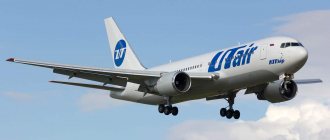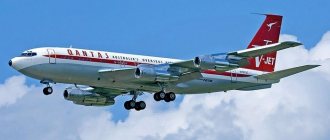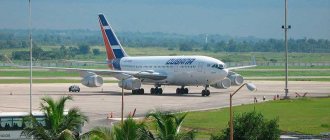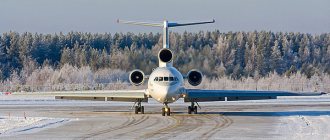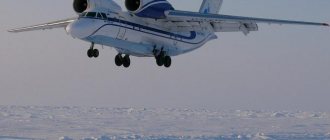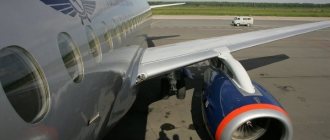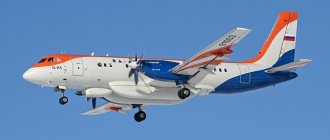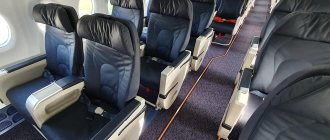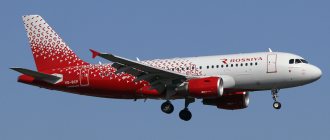Boeing Commercial Airplanes is one of the world leaders in the production of aircraft for passenger and cargo transportation, operating in conditions of fierce competition with Airbus. The fruits of healthy competition are the release of new airliner models such as the Boeing 787 Dreamliner. This wide-body aircraft with twin jet engines is designed to carry up to 330 passengers. Used for long-distance flights. Composite materials, first used in the production of a passenger airliner, have significantly improved its performance characteristics.
Boeing 787 modifications
In total, the Dreamliner has several modifications.
| Modification | Start year of release | Flight range, km | Number of passengers, people |
| Boeing 787-3 (project) | 2010 | 6500 | 296 |
| Boeing 787-8 | 2011 | 13 620 | 242 |
| Boeing 787-9 | 2014 | 14 140 | 290 |
| Boeing 787-10 | 2016 | 11 910 | 330 |
The Boeing 787-3 was supposed to be manufactured to order from Japan for domestic flights, but then the Japanese refused to sign the contract in favor of modifying the 787-8. The latest version of the Boeing 787-10 was delivered to airlines in 2022.
The fuselage of the Boeing 787-9 is extended by 6.5 m, and that of the Boeing 787-10 by 11.5 m compared to the basic version.
Interesting! Boeing Business Jet based on the Dreamliner is produced mainly for private orders. It is produced without exterior painting and interior trim. Interior design and equipment are additionally ordered from specialized companies.
Features of this model
One of the many features of the aircraft is the materials. More than half of the composite materials are used here. In particular, the fuselage, wings, wing liners and flaps are based on carbon components. They provide the aircraft with increased wear resistance, strength and durability.
Manufacturing materials:
- Composite materials – 50%.
- Aluminum – 20%.
- Steel – 10%.
- Titanium – 5%.
Even the turbine blades and injectors through which fuel is injected into the combustion chambers are made of composite materials. Thanks to this, the engines begin to reach operating thrust mode at a temperature lower than that of their predecessors. On the other hand, it reduces the emission of harmful substances into the atmosphere.
Passenger cabin plan
How many seats are inside the cabin depends on the Boeing modification. The cabin layout of the basic version of the 787-8 includes:
- 36 business class seats;
- 206 economy class seats.
Arrangement of seats in rows:
- in business class - 2-2-2;
- in economy class - 3-3-3.
Different airlines may change the cabin layout as desired. For example, make a 1-2-1 layout for business class, 2-4-2 for economy class, or use a single-class cabin.
Business Class
In the privileged compartment there are comfortable chairs with the ability to fold out into a bed. Each seat is a half-cabin, and they are arranged in a herringbone shape.
Seats in rows 1, 3 and 6 may be considered inconvenient, as they are located next to utility rooms and a toilet, and row 6 is in economy class. The noise of the toilet flush is reduced, but frequent movement of passengers and staff, turning on the lights, and the sound when opening and closing doors can interfere with proper rest.
Passenger reviews of the Boeing 787-900 Dreamliner
04/07/2018, flight from KML, seat 10C
Terrible place! The seat is located near the aisle, so it is constantly touched by passengers and crew members. I stretched out my legs, but the flight attendants coming out of the kitchen area tripped over them. I don’t recommend it: if you need extra space, sit by the window.
02/05/2018, flight from KML, seat 6K
A standard option for the business sector: there is enough space and the chairs are comfortable. True, neither I nor the flight attendant were able to recline the seat 180˚. The USB port didn't work well either.
04/24/2018, flight with United Airlines, seat 3L
If a company sells premium class tickets, it needs to be made convenient! At least no worse than on board the 777-300! I paid $9,000, and as a result I was forced to disturb my neighbor when I had to go to the toilet. And the flight was long, so I got up several times. If I have to make my way to the aisle, it's definitely not premium.
04/18/2018, flight with United Airlines, seat 16J
Great place, I stretched my legs without any problems. If possible, I will reserve tickets for 16J next time.
Economy class
Reclining comfortable seats with a standard distance between them provide an acceptable level of comfort.
Many people consider the best seats in economy class to be the 7th row and 26th row, where there is more space in front of the seats. But some people don’t like the fact that the eating tables are located in the armrests. The rows may not match in different versions of the interior. For passengers in the 25th and 37th rows, the noise from the kitchen and toilet may seem unacceptable. The 38th row is also closed by partitions with limited visibility. However, there are no completely uncomfortable seats on the plane; everyone chooses according to their preferences.
Where is the best place to sit on a plane?
The B787 airliner has seats of increased comfort with increased space for a convenient location. Many airlines around the world offer the service of booking the best seats in the cabin for a fee. We also suggest that you familiarize yourself with -
Features of seats:
- The most comfortable seats for a flight are located in the business class cabin. They have a wide and soft base. The equipment includes a multifunctional backrest lowering mode, monitors with a multimedia entertainment program, individual LED lighting and sockets for recharging mobile equipment. The increased seat pitch allows passengers to sit comfortably for a comfortable flight and unhindered access to the cabin aisle without distracting the neighbor sitting next to them.
- Convenient seats for air travel are also available in the economy cabin. They are located in rows 11, 31 and 32 (except for the center row) and have increased legroom. Special partitions are installed in front of the seats in the first row of the cabin. On the planes of many air carriers, these partitions have special mechanisms for attaching baby bassinets. The rules for traveling on a plane with a child under 3 years old can be found here.
- Seats in the last rows of the cabin are considered inconvenient for a flight. On the Boeing 787 they are located in rows 24, 41 and 42. The main disadvantage is the proximity to the toilets, where other flight passengers often rush, creating noisy queues. Some chairs installed close to the partition have locked backrests.
Before selecting and booking a seat on a B787, research the specific cabin layout used by the carrier of your choice.
Other Boeing aircraft models with interior diagrams:
Review and layout of the passenger cabin of the Boeing 737 MAX 8 Boeing 777 - review, modifications and characteristics, cabin diagram Description and layout of the cabin of the Boeing 747 passenger aircraft Boeing 737-900 - review, cabin layout, where is the best place to sit on the plane Description and layout of the cabin of the Boeing passenger airliner 777-300 Boeing 737-500 - review, cabin layout, where is the best place to sit Boeing 747-300 - review, cabin layout, where is the best place to sit Boeing 737-700: characteristics, cabin layout, best seats Characteristics and review of the Boeing 777-200 cabin
General characteristics of the interior
When creating the interior space of the Dreamliner, the latest developments were applied, which were reflected in an increase in the level of passenger comfort:
- The luggage compartments of the new Boeing have been increased in width by a third compared to previous generations of aircraft. They are designed so that they take up minimal space above your head.
- The ceiling is made in the form of an arch, which visually increases the space and makes you feel more comfortable.
- LED lighting changes color tones at different stages of flight. Blue light gives the ceiling a feeling of transparency, the effect of the sky above.
- The size of the portholes has been significantly increased. The classic curtains have been removed and replaced with an electronic dimming system that changes the transparency of the glass. Even in bright sunlight, the style of interior lighting is maintained. Dimming is performed centrally and individually, using a button at the porthole. The transparency of the glass does not completely disappear. In the toilet there is a curtain on the porthole.
- The microclimate system maintains air humidity.
- Each seat has an individual display for viewing flight information, watching movies, and playing video games. WiFi is available on board. An individual outlet will help you recharge your mobile device in a timely manner.
- The toilets have become more spacious. If you unfold the common partition between the two toilet stalls, a wheelchair can be placed there.
Interesting! The food offered on board the Dreamliner is distinguished by the variety and high taste of the dishes.
Design
The design of the long-haul airliner includes lightweight composite materials, modern communication systems, and highly efficient engines. According to the manufacturer, this model is 20% more fuel efficient compared to the previous version. The Dreamliner's fuselage parts are manufactured in Washington.
The body contains:
- 50% - composite materials - body;
- 20% - aluminum - in the wings, engine and tail;
- 15% - titanium alloy - in fastenings;
- 10% - steel - strength elements;
- 5% - other materials.
At the end of 2022, over 599 aircraft had been produced. The cost of one Boeing varies from 225 to 306 million US dollars.
The average piloting speed of this aircraft model is 900 km per hour. Flight altitude varies from 12 to 13 km. – standard indicator for passenger transportation.
Motors are used with low noise levels from:
- General Electric;
- Rolls Royce.
The luggage compartment capacity is 2 times higher than that of the previous model.
Cockpit
The cockpit of the “Dream Liner” involves the use of wide-format screens for flight control: they, like military airliners, have a head-up display (HUD), recording any information.
The cabin is strikingly different from all previous designs by Rockwell Collins:
- 5 liquid crystal displays are connected to the interface;
- 2 HUD displays;
- Ethernet Internet standard – ARINC/664, protected by multi-stage security protocols that exclude access by ordinary users.
The same cockpit is used in the MS-21 and Comac C919, on the Orion space models.
Pilots note that the cockpit is easy to use and intuitive. The energy system is a consolidation of 7 powerful energy generators:
- emergency – 2 pcs.;
- in a jet engine - 2 pcs.;
- in the emergency turbine - 1 pc.
Lithium-ion batteries are the most effective solution for aircraft, produced by GS Yuasa - 2 pcs. weighing 29 kg each. The first provides Boeing with an uninterrupted supply of energy while on the ground and is capable of operating in emergency mode in the event of generator failure. The second is used to start engines in the event of an auxiliary power unit shutdown. Used to maintain the functioning of auxiliary aviation systems. Despite the many advantages, the new battery system has a drawback associated with a higher fire hazard compared to the nickel-silicon system.
Cabin
The cabin of the Boeing 787 aircraft is equipped with the latest technology: the extensive dimensions of the interior are 5.5 m, which makes it an ideal option for customization to suit the needs of different categories of passengers: from economy class to super VIP and business clients.
The gap between the seating arrangements is:
- 45-60 inches or 115-145 cm for 1st grade;
- 90-100 cm or 35-40 inches for the “Business” class;
- 85 cm or 33 inches for Economy class.
The most common combination is 3+3+3 for Economy class passengers. For tall and large passengers, this seating arrangement is not comfortable during a long flight.
The size of the porthole, which, by the way, does not have curtains, is 25 x 45 cm - this is the highest figure of all standard liners. The glass is capable of automatically adjusting the absorption of light in the cabin. In addition, buttons have been developed for passengers that allow them to quickly change the transparency by simply pressing. They left the curtain in the toilet.
There are no light bulbs in the cabin of a Boeing 787! Instead, LED lighting is used, the color and brightness of which can be adjusted.
The cabin has a new system for regulating atmospheric pressure at a level of 1.8 thousand m. For comparison, in earlier models the pressure was maintained at a level of 2-2.5 thousand m. Now, thanks to innovations, harmful exhaust gases do not enter the cabin, and the moisture level in the cabin tends to 15%. Previously, at Boeing it was at around 4%.
Another distinctive feature of Boeing is the increased size of the toilets, which allows even people in wheelchairs to travel. The upper shelves in the cabin can safely store 4 huge suitcases, and the Smoother Ride Technology flight system allows passengers to feel comfortable even after entering a pocket of air and turbulence.
Sensors in the aircraft cabin allow you to track the slightest changes in air pressure, and the flaperon system is adjusted automatically using the latest computer technology.
Interior layout
The following factors were taken into account when creating:
- spaciousness;
- comfortable light;
- big windows;
- wide shelves for luggage;
- availability of displays for each passenger.
Boeing 787-8
Main technical characteristics of the Boeing 787 Dreamliner (basic version 787-8)
| Dimensions | |
| Length, m | 56,7 |
| Wingspan, m | 60,2 |
| Height, m | 17.0 |
| Wing area, sq.m | 325 |
| Cabin width, m | 5,5 |
| Fuselage width, m | 5,8 |
| Fuselage height, m | 8 |
| Weight | |
| Take-off weight (max), kg | 227 900 |
| Landing weight (max), kg | 172 400 |
| Empty weight, kg | 119 950 |
| Weight without fuel (max), kg | 161 000 |
| Fuel tank capacity, l | 126 200 |
| Cargo capacity. cube m | 138.2 (28 LD3 containers) |
| Flight data | |
| Flight range at maximum load, km | 13 620 |
| Cruising speed (max), km | 902 |
| Maximum speed, km/h | 956 |
| Flight altitude (max), km | 13100 |
| Run length, m modernized | 3 100 2 600 |
| Fuel consumption, kg/hour | 4 800 |
| Engines | 2 x Rolls-Royce Trent 1000 or 2 x General Electric GEnx-1B |
Boeing 787-9
For the Boeing 787-9 model, all dimensions are identical except for length. It is 63 m.
| Weight | |
| Take-off weight (max), kg | 254 000 |
| Landing weight (max), kg | 193 000 |
| Empty weight, kg | 126 000 |
| Fuel tank capacity, l | 126 200 |
| Cargo capacity. cube m | 174.5 (36 LD3 containers) |
| Flight data | |
| Flight range at maximum load, km | 14 140 |
| Cruising speed (max), km | 902 |
| Maximum speed, km/h | 956 |
| Flight altitude (max), km | 13100 |
| Run length, m | 2 900 |
| Fuel consumption, kg/hour | 5 400 |
| Engines | 2 x Rolls-Royce Trent 1000 or 2 x General Electric GEnx-1B |
Boeing 787-10
The length of the aircraft is 68.27 m. Other dimensions are similar to the 787-8 model
| Weight | |
| Take-off weight (max), kg | 254 000 |
| Landing weight (max), kg | 202 000 |
| Empty weight, kg | No data |
| Fuel tank capacity, l | 193 200 |
| Cargo capacity. cube m | 192.6 (40 LD3 containers) |
| Flight data | |
| Flight range at maximum load, km | 11 910 |
| Cruising speed (max), km | 902 |
| Maximum speed, km/h | 956 |
| Flight altitude (max), km | 13100 |
| Run length, m | No data |
| Fuel consumption, kg/hour | 5 700 |
| Engines | 2 x Rolls-Royce Trent 1000 or 2 x General Electric GEnx-1B |
Advantages of the Boeing 787
The new Boeing has undeniable advantages, which distinguishes it from all previously produced aircraft:
- The tips of the swept wings are bent variably, this ensures an increase in lifting force.
- With the help of an extended fuselage, passenger capacity has increased.
- Specially developed new engines have significantly reduced background noise (by 20%). This is noted by all air passengers who have already flown on the Dreamliner.
- The luggage compartment has become half as spacious due to the flat bottom of the fuselage.
- Less fuel consumption.
- The weight of the aircraft has been reduced through the use of composite materials.
- In the cockpit, images from working monitors are projected onto the windshield for easy reading of parameters; sensors are installed that measure turbulence and other additional equipment.
Interesting! An infrared scanning device is undergoing final testing, with the use of which clouds will not interfere with pilots’ good visibility.
The Dreamliner is equipped with the latest electronic system. Information about aircraft operating parameters and other data is displayed on the display. During the flight, data on the operation of structural components and assemblies is collected and automatically transmitted to ground operators. Once the aircraft lands, there is no need to carry out diagnostics; maintenance can begin immediately.
How is the cockpit different?
The Fly-by-wire system used is the same as on the 777. Many controls are unchanged, allowing pilots to handle different types of aircraft without retraining.
The advantages of the Dreamliner include the presence of projection indicators: devices that display information on the windshield. Also available to the crew are electronic flight plans, which can be seen on 2 screens (one for the pilot). The computer displays the information necessary to control the vessel. The aircraft is also equipped with installations for real-time diagnostics: sensors take instrument readings and transmit them to the ground. The measure allows us to reduce the time required to service aircraft.
Design features of the Boeing 787
Engines
The Dreamliner engine is manufactured by two different companies. If necessary, you can replace one with the other, since the connection is made according to the same scheme. The first-invented design of engine nacelles helps reduce the noise produced. This is achieved by installing toothed chevrons in the rear area of the nacelle, thanks to which the jet stream mixes smoothly with the air.
Composite materials
The widespread use of carbon composite materials has led to a reduction in the weight of the aircraft and, as a result, reduced fuel consumption. Half of the composites are used in the manufacture of the interior; the entire working part of the engine consists of them, with the exception of the main edge made of metal.
Interesting! The pressure inside the cabin made of composites with greater elasticity is in accordance with the altitude of 1.8 km (for an aircraft with an aluminum fuselage - 2.4 km).
Wings
The swept wings are longer than other airliners of this class, which provides increased elasticity. Electrical anti-icing equipment and flap mechanisms are designed as a common unit. This reduces the possibility of operational failures and simplifies maintenance.
Salon
The operation of the microclimate system is organized in an innovative way. Air is not taken from the engines with subsequent cooling and supplied to the cabin, but is pumped by compressors from the external environment. Natural humidity is provided inside.
Power supply system
Electricity consumption on board has increased significantly. The liner's power supply is provided by 7 generators and 2 lithium-ion batteries. One battery is used when the aircraft is on the ground when the generators are stopped. An additional function is emergency power supply in flight in case of failure of all generators. The other powers auxiliary systems and is used to start engines.
First Class on the Boeing 787-900 Dreamliner: Passenger Experience
Josh Cahill, who traveled with British Airways from London to Beijing, shares his experience. He purchased a ticket for seat 1A, located in the premium section. What did Josh say about the flight?
“The journey began at Terminal 5 of London Airport. There was no line at registration, and the security service completed the inspection in 10 minutes. Then I went to the lounge area, where I rested and had a snack before the flight. The food was mediocre, but I liked the champagne.
When we boarded, I thought that I had been mistakenly assigned to the “business” sector. If you compare the conditions with offers from Emirates or Lufthansa, neither the service, nor the interior design, nor the comfort can withstand the competition.
What I saw on board did not surprise me: comfortable seats, the presence of USB ports and sockets are the norm, not the exception. The lack of Wi-Fi was disappointing, but the company plans to introduce it on aircraft only next year. In addition, the film that was shown to the passengers did not interest me, so the flight was a bit boring.
Breakfast and dinner left a mixed impression: on the one hand, I liked the food, as did the wine. On the other hand, they didn’t bring me a hot towel.
What deserves praise? The bedding was comfortable, especially the pajamas. But the chair seemed a little narrow: I have already said that its design requires improvement. But the service was not satisfactory, because the flight attendants were attentive and friendly.
Overall, I was pleased with the flight, although I was left with the impression that I was flying on a “business” trip. Inexperienced travelers will like this option, but if you know in practice what great service is, then this will not impress you.”
History of the Boeing 787
At the end of the 90s, the popular Boeing 767 began to increasingly no longer meet modern requirements. The innovative developments of the Airbus concern have allowed the aircraft of the European aircraft manufacturer to get ahead of their competitors. What was needed was a new long-haul airliner that would consume less fuel than all existing and previous aircraft and have high speed. Fuel savings were supposed to be achieved by reducing the flight duration.
Having named the new airliner Boeing Sonic Cruiser, aircraft manufacturers began developing the project. After the 2001 terrorist attacks in the United States and the subsequent rise in oil prices, it became clear that saving fuel came to the fore. The technical complexity of Sonic Cruiser and the high cost of the project forced it to be stopped.
In April 2004, the start of a new project, 7E7, was officially announced. The achievements of the aviation engineers of the previous version were preserved, the best of them moved to 7E7. A year later, the project changed its name to Boeing 787 Dreamliner.
The first flight test of the Dreamliner was scheduled for 2007, but suppliers of some components did not fulfill their obligations. As a result, flight tests of the aircraft took place in the winter of 2009.
The airliner made its first flight for testing in real operating conditions between Seattle and Tokyo in the summer of 2011. Then the Japanese week-long tests continued. After 2 months, the Dreamliner passed certification, and in October 2011, it carried passengers for the first time in Japan.
Interesting! In January 2013, Boeing 787 flights were grounded by a joint decision of the European Safety Agency and the US Federal Aviation Administration. The official reason is to prove the safety of lithium-ion batteries. Already in April, commercial operation of the aircraft resumed.
Short story
The life of the project begins in 2004. On April 26 of that year, Boeing’s new creation, a project codenamed 7E7, was highlighted in the media as an improved prototype of the Sonic Cruiser. Already in January 2005, the official name of the 7E7 was announced - for the Boeing 787 .
A year later, one could see a model of a finished aircraft with a specific design. 4 years later, after a series of lawsuits related to the delay in the delivery of life support parts for the aircraft due to the fault of manufacturers, on December 15, 2009, the Boeing 787 Dreamliner took off.
The aircraft participated in exhibitions, for example, at Farnborough, one of the world's largest air shows. Visitors to MAKS 2011 could get acquainted with the interesting design of the Dreamliner.
The first delivery of the Dreamler was made on September 25, 2011. Test piloting was carried out on July 2, 2011 on the route Seattle - Haneda. The aircraft was tested with the participation of All Nippon Airways (ANA). The Boeing 787 was awarded an official certificate confirming the Dreamliner's ability to carry passengers on August 26, 2011. The aircraft entered mass production and already made its first flight on October 26, 2011.
The Boeing 787 is the world's first aircraft with a monolithic main section fuselage. Conventional prefabricated aircraft use more than 45 thousand rivets: the new model made it possible to save money due to the solidity of the body.
Total development costs for the Dreamliner exceeded $32 billion.
Unrealized project
Interestingly, the history of the Dreamliner dates back to the late 1990s. At this time, leading Boeing engineers and designers came to the conclusion that the Boeing 767 model was hopelessly outdated, and that a new competitive solution was required - the Sonic Cruiser.
Unfortunately, due to the tragic events of the Twin Towers on September 11, 2001, the expensive project was postponed indefinitely. In addition, the Boeing 787-3 – for 295 passengers with a flight range of over 6.5 thousand km – was not put into production. The aircraft was to be used for short-distance transport. Considered as an alternative to the Airbus A300 and Boeing 767 in Japanese domestic airlines. But fate decreed otherwise, and the project was closed on 12.2010 in favor of the 787/8 model.
Place of production
The main and very first plant of the Boeing aircraft concern is located in Seattle. But the company also has enterprises in other cities. It was decided to produce the Boeing 787 Dreamliner in Everett (Washington) and at a new facility in North Charleston (South Carolina). Components are supplied by partners from many countries around the world.
Interesting! Before production of the new planes began in North Charleston in 2011, Seattle was hit by a wave of union strikes against the decision. Unions believed that production was being delayed as punishment for previous strikes that had caused delivery deadlines to be missed. The conflict was subsequently settled with a promise to locate the assembly of the new Boeing 737MAX in Seattle.
Advantages of low wings
The low position of the wings gives the liner the following advantages:
- Safe emergency landing. If the landing gear does not come out, the plane is grounded on its belly. In this modification, the main blow will be taken by the wings.
- Landing on water. In this case, the fuel tanks located in the wings will serve as pontoons that keep the aircraft afloat.
- Shortened landing gear. Thanks to this design, the racks have become lighter and more durable.
- Ease of repair and maintenance of motors. Convenience lies in the low location of the wings, equipped with turboprop engines.
Cabin
Operating companies
As of autumn 2022, the Dreamliner of various modifications is operated by 43 aviation companies and another 19 are awaiting delivery, including Aeroflot. According to the latest news, the Russian airline is abandoning the acquisition, and the contract is being transferred to Rostec, which will look for a buyer.
| Company | Quantity, pcs. |
| AeroMéxico (Mexico) | 6 |
| Air Austral (Australia) | 2 |
| Air Canada (Canada) | 30 |
| Air China (China) | 11 |
| Air Europa (Spain) | 8 |
| Air France-KLM (France-Holland) | 2 |
| Air India (India) | 27 |
| Air New Zealand (New Zealand) | 10 |
| A.L.C. | 5 |
| All Nippon Airways (Japan) | 62 |
| American Airlines (USA) | 32 |
| Avianca (Colombia) | 12 |
| Azerbaijan Airlines (Azerbaijan) | 2 |
| British Airway (UK) | 25 |
| Business Jet/VIP | 7 |
| China Southern Airlines (China) | 10 |
| CIT Leasing Corporation | 7 |
| Ethiopian Airlines (Ethiopia) | 16 |
| Etihad Airways (UAE) | 18 |
| Hainan Airlines (China) | 20 |
| ILFC (USA) | 51 |
| Japan Airlines (Japan) | 35 |
| Kenya Airways (Kenya) | 9 |
| Korean Air (South Korea) | 5 |
| LATAM Airlines (Chile) | 18 |
| LOT (Poland) | 8 |
| MG Aviation Limited | 4 |
| Norwegian Air Shuttle (Norway) | 6 |
| Oman Air (Oman) | 2 |
| PrivatAir (Switzerland) | 1 |
| Qantas (Australia) | 12 |
| Qatar Airways (Qatar) | 30 |
| Royal Air Maroc (Morocco) | 5 |
| Royal Brunei Airlines (Brunei) | 4 |
| Royal Jordanian (Jordan) | 3 |
| Saudi Arabian Airlines (Saudi Arabia) | 8 |
| Scoot (Singapore) | 15 |
| TUI (Thailand) | 15 |
| United Airlines (USA) | 31 |
| Uzbekistan Airways (Uzbekistan) | 2 |
| Vietnam Airlines (Vietnam) | 8 |
| Virgin Atlantic (UK) | 14 |
| XiamenAir (China) | 10 |
| Anonymous customers | 5 |
